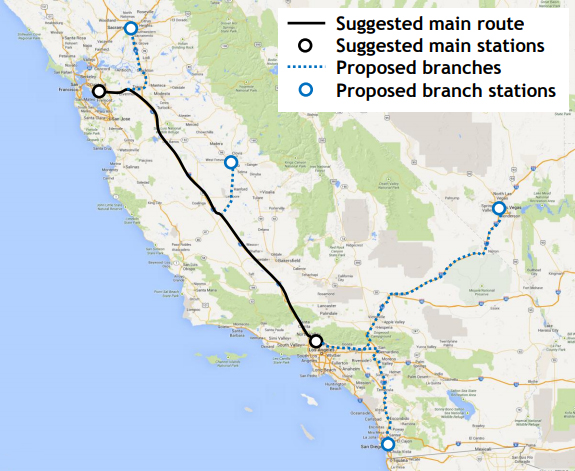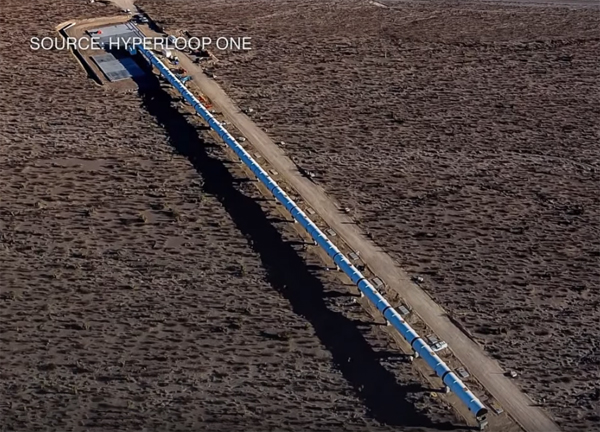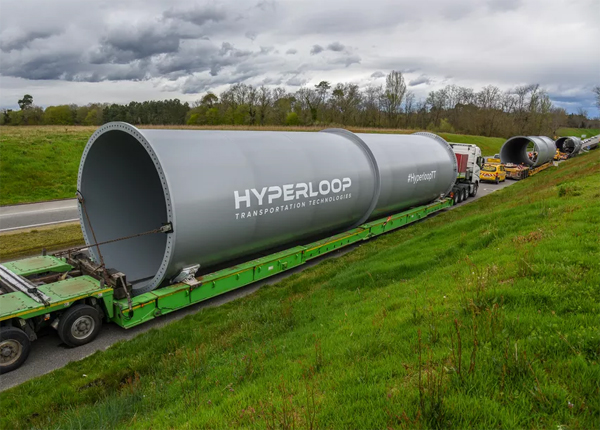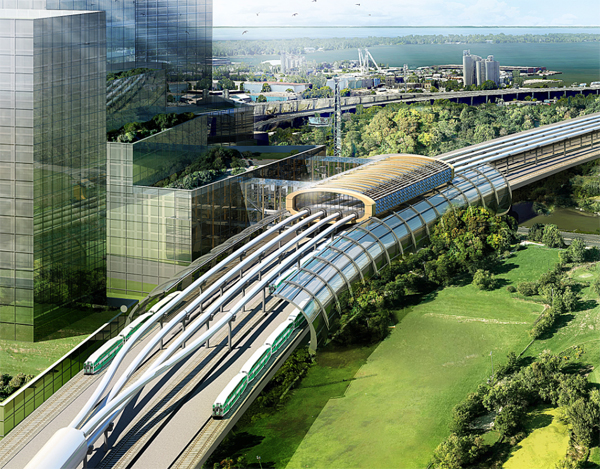California’s Transportation Future, Part Two – The Hyperloop Option
In July 2012, Elon Musk sat down for a “fireside chat” with Sara Lacy, founder of the PandoDaily website. In between discussions of Paypal, Tesla, and SpaceX, 43 minutes in, Musk unveiled his idea for the “Hyperloop,” a new transportation technology that “incorporates reduced-pressure tubes in which pressurized capsules ride on air bearings driven by linear induction motors and air compressors.”
The concept wasn’t new. Hyperloop concepts have existed for nearly 200 years. Small scale “pneumatic railways” were actually built in Dublin, London, and Paris, mostly as a novelty, as far back as the 1850’s. In 1910, American rocket pioneer Robert Goddard proposed a train that would go from Boston to New York in 12 minutes. Goddard’s design advanced the technology, replacing wheels with magnetic levitation of the passenger capsule inside a vacuum-sealed tunnel.
Musk’s “Hyperloop Alpha” study was released by a joint team from SpaceX and Tesla in August 2013. This 58 page study remains an excellent investigation of the financial and engineering feasibility of Hyperloop technology. The concept is relatively simple. Passengers and freight travel in “pods” or “capsules,” through a tube that has had all the air pumped out, eliminating the friction of air resistance. Moreover, these pods ride on electromagnets, repelled away from the inner surface of the tube, eliminating the friction of wheels. Not only would these electromagnets keep the pods levitated off the inside surfaces of the travel tube, but through “linear induction,” they would provide the force to propel the pod through the tube. Most proponents claim these innovations make speeds feasible in excess of 700 MPH.
A system like this, assuming there were nonstop service, could deliver passengers from San Francisco to Los Angeles in around 30 minutes. From the Hyperloop Alpha report, here is the route a Hyperloop system could take in California:
“Hyperloop Alpha” – The Original Proposed Route Connecting SF to LA

The Hyperloop Alpha study was released as an open source document, and none of the companies currently developing Hyperloop systems are directly affiliated with Musk or his companies. Since 2013, at least three noteworthy companies have emerged. Each of these companies have developed substantial technical changes to the design imagined in Musk’s Hyperloop Alpha study. And sadly, despite two of them being headquartered in California, none of these companies are currently proposing a system to connect San Francisco to Los Angeles.
THE MAJOR HYPERLOOP CONTENDERS
Virgin Hyperloop One, founded in 2014, is based in Los Angeles. They have over 300 employees and have raised over $295 million in investment capital. The company was rebranded in October 2017 after receiving a significant investment from Virgin Group founder Richard Branson. In May 2017 they began testing a Hyperloop system on a 500 meter “development loop” built in the desert north of Las Vegas. Regarding next steps for the company, a spokesperson for Virgin Hyperloop One claimed “we’ve already seen ground-breaking commitments in India, UAE, Saudi Arabia and the U.S.” He said construction of the Mumbai-Pune route in India could begin as early as 2022 and be completed in less than five years for passenger operations.
Virgin Hyperloop One’s 500 meter long “DevLoop” in the Nevada Desert

Hyperloop Transportation Technologies, or “HTT,” founded in late 2013, is based in Culver City in the Los Angeles area. They claim to have over 800 collaborators located all over the world who are working mostly in exchange for stock options. While HTT uses crowd sourcing and is crowd funded, they have developed proprietary technology. An HTT spokesperson reached for comment said “The model is tricky to define. It isn’t open source, we call it ‘open collaboration.’ We don’t disclose our patents and schematics, we have signed contracts and non-disclosure agreements. But this way qualified candidates can be found worldwide and can contribute their talents in exchange for stock options.”
A Harvard Business School case study on HTT had this to say about the company’s prospects using this business model: “Rather than employees, HTT has invited over 800 people to contribute a minimum of 10 hours per week in exchange for future equity. Everything from recruitment, incentives, culture, technology, and intellectual property controls are handled with the idea that a community can work together to solve a global problem (transportation) by ‘turning a collective passion into a vision and the vision into a reality.’ The open question is how this approach will fair as the organization moves from design to delivery.”
Apparently so far HTT’s novel approach to financing and recruitment is working, because in April 2018 they announced construction of a kilometer-long test track near its R&D center in France near Toulouse. In addition to being headquartered in California with a test track underway in France, HTT has entered into government partnerships to perform feasibility studies and testing in Slovakia, India, as well as in the U.S. states of Ohio and Illinois. HTT also has impressive commercial technology partners including AECOM, Ansys, and Oerlikon.
Hyperloop Transportation Technology’s full-scale tubes are transported to French test site

Another entrant in the Hyperloop industry is Transpod, founded in 2015, based in Toronto with satellite offices in Italy and France. In 2018 they announced plans to build a half-scale, 3 kilometer test track in France. Transpod president Sebastien Gendron, reached by phone, said construction would start this summer. He expected it to be ready for tests to begin within a year, or by Spring of 2019. He stated the decision to go at half-scale was based on a need to finalize the technology based on the results of the testing.
The designs Transpod are exploring are illustrative of the variations in the engineering solutions being developed at these three main competitors. Gendron explained that to reduce the cost per kilometer of tube, a major factor is the type of magnetic levitation. “We are developing technology to keep 80-90% of the levitation system on the vehicle itself,” he said. This would eliminate the need for expensive permanent magnets powered up for the entire length of the corridor. Like his counterparts at Virgin One Hyperloop and HTT, Gendron was reluctant to explain further details of their proprietary technology.
Hypothetical Hyperloop Station (artists rendering from Transpod)

WILL HYPERLOOP WORK AND IS IT SAFE?
A rather caustic attempt to debunk Hyperloop technology was released in July 2016 by Phil Mason, a British scientist and videoblogger who has nearly 800,000 subscribers to his YouTube channel. His video, entitled “The Hyperloop Busted!,” has gotten over 1.5 million views, and takes a dim view of Hyperloop technology. Some of Mason’s criticisms are valid but obvious, and not deal killers. In particular, that Hyperloop systems will cost more than claimed by proponents, and that Hyperloop systems will use more energy than claimed by proponents. Mason is almost certainly correct in these criticisms, but they don’t necessarily kill the argument for Hyperloop transportation solutions. How much more will they cost? How much more energy will they consume? Other concerns merit more attention.
For example, Mason claims that current designs for lengthy Hyperloop routes don’t take into account thermal expansion of metal tubes that are literally hundreds of miles long. When reached for comment on this challenge, a Hyperloop One spokesperson said “We have successfully built a test track in the Nevada desert which is the perfect environment to test the impact of temperature changes upon the Hyperloop tube as temperatures range from over 100F to below freezing. The DevLoop tube experiences daily movement due to expansion and contraction of the steel during temperature swings. To accommodate this movement, we have designed proprietary structural systems into the DevLoop columns to allow for this movement which allows the tube to expand and contract without causing structural damage to the tube, vacuum, and other supporting mechanisms. As systems get longer, we are confident that we can build a flexible, strong, affordable, safe system that can endure a multitude of weather conditions given our testing experience in the harsh climate of the Nevada desert.”
Until systems get longer, it is difficult for Hyperloop proponents to muster convincing arguments that it will be absolutely safe. Depressurizing a tube several hundred miles long is a major engineering feat requiring a lot of energy, as is constructing a tube that long that is capable of structurally withstanding depressurization. There are many unanswered questions.
How will passenger pods exit the main Hyperloop route and switch onto sidings to board and disembark passengers at intermediate stops? How will pods airlock themselves to exit points at the station without letting air into the tube? Since these pods will be traveling at very high speeds, packing almost unimaginable kinetic energy, how certain can operators be that a pod might never bump into the inside of the tube? Wouldn’t a minor “bump,” at high speed in a narrow tube, result in a catastrophic collision, rupturing and depressurizing the tube and likely killing not only the passengers in the colliding pod, but all the passengers in all the pods transiting the tube as they encounter a wall of air?
THE TUNNELING OPTION
One of the strongest arguments for Hyperloop systems, should they function as planned, is that implementing them uses less space. Hyperloop systems can be put onto pylons, elevating the tubes so they don’t disrupt activities on the ground below them, whether that is farmland or the median of a divided highway or freeway. Hyperloop tubes can also be buried underground, enabling them to establish routes through densely populated cities.
It may be that the first use of Hyperloop technology will be within urban areas, where the space advantage they offer constitutes a more decisive argument for investing in a system than the maximum speeds they might achieve on longer routes. It may be the technology can be perfected at lower, safer speeds. Elon Musk, who is not directly involved with any of the companies vying to build the first Hyperloop systems, has founded The Boring Company, where he hopes to apply the same aggressive innovation to tunneling technology as he has applied to rocketry with SpaceX.
If SpaceX challenges NASA in the field of rocketry, The Boring Company faces a similarly entrenched competitor in the German firm Herrenknecht AG. Founded in 1975, its massive factory nestled along the Rhine, this multi-billion dollar company sells tunneling systems – sophisticated snakelike machines that can be over 1,000 feet long – all over the world. Herrenknecht TBMs (tunnel boring machines) dug the 35 mile long Gotthard Base Tunnel under the Swiss Alps in 2009, the longest and deepest tunnel in the world. Today, most of Herrenknecht’s TBMs are digging subways in urban areas, primarily in the Middle East and Asia. For more on Herrenknecht and tunneling technology today, read “The Long Dig” (New Yorker, 2008), or watch this fascinating animation of an operating TBM.
Tunneling, like blasting payloads into low earth orbit, is extremely expensive. But The Boring Company claims tunneling costs can be dramatically reduced. On The Boring Company’s FAQ page, the following innovations are proposed: (1) Triple the power output of the TBM’s cutting unit, (2) Continuously tunnel instead of alternating between boring and installing supporting walls, (3) Automate the TBM, eliminating most human operators, (4) Go electric, and (5) Engage in tunneling R&D, “the construction industry is one of the only sectors in our economy that has not improved its productivity in the last 50 years.”
Apparently tunneling, whether for Hyperloop pods, or just electric powered “skates,” has the attention of the Los Angeles City Council, which in April 2018 approved a CEQA exemption so The Tunneling Company can immediately begin digging a 14 foot diameter, 2.7 mile long tunnel through the heart of West LA. The Boring Company believes they will complete this tunnel in 9 months. Don’t laugh. SpaceX is now routinely reusing first stage rocket boosters, an achievement that eluded NASA for decades. And imagine how long it would take LA Metro to complete the same project.
According to The Tunneling Company, tunneling using conventional methods costs about $1.0 billion per mile. But the current standard for a one-lane tunnel is approximately 28 feet. By placing vehicles on a stabilized electric skate, the diameter can be reduced to less than 14 feet. The area of a 14 foot diameter circle is 615 square feet, whereas a 28 foot diameter circle has an area of 2,463 square feet, exactly four times as much. If Musk is correct that a 14 foot tunnel – which just happens to be the diameter of the tunnel he’s been approved to dig in Los Angeles – is a viable size for mass transit, he’s just brought costs down by 75%. If other proposed innovations are successful, The Boring Company may reduce tunnel costs from $1.0 billion per mile per lane to $100 million per mile per lane. As shown in this animation, electric “skates” can carry cars through these tunnels at speeds of 120 MPH, using elevators to move them down to the tunnel and back up to the roads.
THE FUTURE OF HYPERLOOP TECHNOLOGY
The pace of innovation clearly makes a case that California’s high speed rail project could end up being obsolete before it’s even completed, at staggering expense. But can the same be said for the Hyperloop? What are the emerging competitors to Hyperloop?
Within urban areas, where transportation challenges remain most acute, tunnels underground don’t have to move people at 700 MPH through zero PSI to constitute breakthrough improvement. They can use proven, much safer technology, such as electronic skates that transport cars through tunnels at normal air pressure. Traveling from the San Fernando Valley to downtown Los Angeles takes about 15 minutes if you’re going 120 MPH. You don’t need to go faster.
Between urban areas, there is a clear case for Hyperloop as a superior competitor to high speed rail. Assuming the safety issues and remaining technical challenges can be overcome, it is probably cheaper to construct, and it’s much faster. But these are big ifs. And even if Hyperloop can compete with high speed rail, that’s a low bar. What about conventional air travel? Can Hyperloop construct a network of zero PSI tunnels that connect every major city in California, the way, for example, Southwest Airlines does today?
And at what point does Hyperloop itself become obsolete, unable to cost-effectively compete with new innovations? When the energy density of batteries descends to under 400 watt-hours per kilogram (the best are currently already packing about 300 watt-hours per kilogram), high-speed electric planes become feasible. Because these planes would not have air-breathing jet engines, they could ascend to 60,000 feet where the thinner air offers less resistance, allowing them to travel at supersonic speeds using less energy. And because these planes could be designed like the V-12 Osprey, with rotating engine nacelles, they could take off and land vertically, eliminating the need for airport runways.
One big problem with Hyperloop, ultimately, is same problem with any rail transport. You can only go where the rails – or tubes – go. And only very specialized vehicles can go onto these rails, or into these tubes. Roads, on the other hand, can accommodate anything with wheels. The air, an even more versatile transportation medium, can accommodate anything that flies.
The next article in this series will examine advances in small scale transportation innovations. Advanced vehicles designed for roads and for flight. These new technologies will deliver passengers and freight at high speeds, with ranges that reach from the fringes to the center of large urban areas. It may be that embedded rail or tunnel technologies only make sense in the most densely packed urban cores, or along heavily traveled transportation corridors.
It makes sense to come up with high speed options to connect California’s North Central Valley to the Silicon Valley, or to connect California’s South Central Valley to the Los Angeles Basin. To connect the Silicon Valley to Los Angeles does not make sense for high speed rail, because it doesn’t go fast enough to compete with jets. Whether or not Hyperloop technology provides any of these solutions depends on whether it can indeed reduce the costs significantly below high speed rail, at the same time as it delivers safer, much faster transportation than high speed rail. It also depends on what other high-tech transportation solutions are on the way, using those most versatile of all transportation technologies, wheels and wings.
* * *
This article is the 2nd in a series on California’s transportation future. The first installment was “California’s Transportation Future, Part One – The Fatally Flawed Centerpiece,” published in April 2018. Edward Ring co-founded the California Policy Center in 2010 and served as its president through 2016. He is a prolific writer on the topics of political reform and sustainable economic development.
